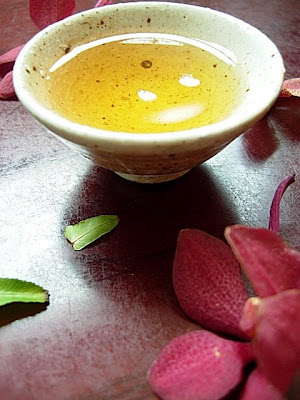 Fireworks explode into the air, men and women dressed in skimp workout gear trickle out of the rural stadium to mark the beginning of a long and hilly run.
Fireworks explode into the air, men and women dressed in skimp workout gear trickle out of the rural stadium to mark the beginning of a long and hilly run.
In this small farming town, the runners pass tea bushes that line the edges of simple farm houses. Within the first kilometers of the run, just on the outskirts of the small town, typical polly-tarped greenhouses are identified by a sign that reads 'Boseong Green Tea Reseach Station'. This is tea country. This is where the most identifiable tea in Korea comes from- Boseong Green Tea.

The course points out of town and into the country where small patches of tea can be spotted on the side of the mountain. The runners take in the sweeping green mountain sides and river valleys- sweat dripping down their heads in the humid sun. One must remember to stay hydrated, a stop at the water station is needed to replenish electrolytes. To ones surprise water as well as tea is offered. One gulps back a cup of green before trudging along once again.
Soon kilometers come and go, muscles, start to tighten and burn- 42.195 kilometers is a long time to run, but the energy of the tea pushes one forth.
More kilometers slip away, more tea is sipped away. Soon one hits the wall as the rolling hills take a toll on aching, burning muscles. Wavering on the brink, barely able to push on, ones body begins to shut down, then almost in that instant, distant chanting can be heard...
“Nok Cha, Nok Cha, Nok Cha”
Nok Cha is Korean for Green Tea... Is ones mind going crazy?!?
The chanting is getting louder, approaching from behind...
“NOK CHA, NOK CHA, NOK CHA”
Soon the small group of men catch up and engulf the exhausted runner. Now we all chant together, “NOK CHA, NOK CHA, NOK CHA”
The mantra of tea induces a last push, a runners high, oral adrenaline. Ones body is broken but feels alive once again. Pushing through to the finish line dispite ones body now in shambles- one gives thanks to tea.
One lines up for green tea noodle soup served with green tea kimchi- special green tea cuisine served right up after the marathon. Ones body is in such rough shape that one is unable to finish the tea laden meal. One collapses at a nearby hotel and, a few hours later, wakes up to excruciating pain as the muscles of the body disdain even the idea of contraction.

A local offers one a lift to the green tea spa, a perfect remedy for these tired muscles. On the way to the spa we snake around valley roads completely surrounded by tidy rows of bright green tea bushes.
Dipping ones tired muscles in 42 degree hot green tea baths puts them at ease.
After an hour or so stepping in the tea, one went down the street to try some of the famous green tea feed pork. Tea is in such quantities here that it is fed daily to the local pigs. One gives thanks for the best pork one will probably ever try and for the life that was sacrificed for this pleasure.

Looking back as one leaves this small town one whispers,
“What a crazy tea filled day.”






















 The lively flavour comes in complex layers and waves, kicking around in ones mouth. Initially, a fresh slippery, minty, sweetness is felt. A lot of sweetness. It makes way for a pleasant slightly sour-bitter-rubbery taste that coats the sides of the tongue, cheeks, but mainly the roof of ones mouth. The mouthfeel is reminiscent of one of those teas that feels like the roof of ones mouth, specifically behind ones front teeth, has turned into rubber.
The lively flavour comes in complex layers and waves, kicking around in ones mouth. Initially, a fresh slippery, minty, sweetness is felt. A lot of sweetness. It makes way for a pleasant slightly sour-bitter-rubbery taste that coats the sides of the tongue, cheeks, but mainly the roof of ones mouth. The mouthfeel is reminiscent of one of those teas that feels like the roof of ones mouth, specifically behind ones front teeth, has turned into rubber.

